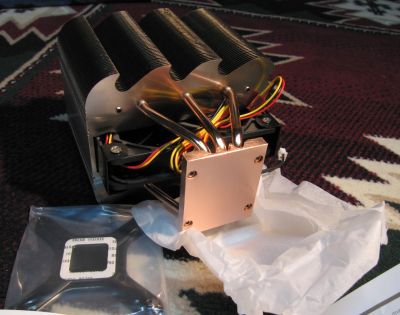Hot technology for cooling

CPU cooler
By Nayu Kim from Toronto, Canada (Tuniq Tower 120 CPU cooler) [CC BY 2.0 (http://creativecommons.org/licenses/by/2.0)], via Wikimedia Commons
On-chip microrefrigeration devices could soon cool electronics for a major reduction in refrigerant use, cost and system volume. In pioneering work, EU-funded scientists have demonstrated deposition of functional refrigerant molecules on silicon.
Utilising magnetic molecules, the on-chip microrefrigeration systems
could be expected to cool below the temperature of liquid helium, i.e.,
around 4 Kelvin or -269 degrees Celsius. Cooling of such materials via
the magnetocaloric effect is achieved with a small change in applied
magnetic field in the order of a few tesla.
Most studies of magnetic molecule-based coolers have been done on
bulk materials. Extending the work to molecules deposited on a substrate
is quite challenging both due to the low temperatures required and the
weak magnetic signal of such small amounts of magnetic material.
EU-funded researchers significantly advanced the state of the art for
both bulk and substrate-deposited forms in the project MAPROMODE.
Two years of research into the physical characterisation at very low
temperatures of certain molecule-based refrigerants in bulk form led to
10 publications in highly esteemed peer-reviewed journals.
In parallel, the team successfully deposited a molecular refrigerant
on a silicon substrate. Researchers then characterised the grafted
molecular refrigerants using advanced magnetic force microscopy (MFM).
MFM is similar to atomic force microscopy (AFM) except it senses the
magnetic surface properties through a magnetic force generated between
the tip and surface.
Exploiting MFM at near-liquid helium temperature, scientists showed
that the molecules maintain their magnetic properties and thus their
cooling ability after deposition. The seminal work was published in a
paper featured on the journal front cover and heralded in a university
press release and the regional and national media. It is the first step
toward realisation of cooling microchips on silicon operating at very
low temperatures such as required by state of the art X-ray and infrared
sensors.
The team continues to investigate ways to reduce the size of the
refrigerators to the smallest scales to accommodate high-tech niche
markets. The ground-breaking molecule-based microrefrigerator technology
developed within MAPROMODE is set to be a hot commodity.
published: 2015-02-26

